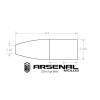Mitty38
Well-Known Member

Ok here is the Bullet I will be working with. Figure I may as well start a thread here following my journey, Keep it all in one place.
The gun is an AR15 M4 clone, with a carbine length gas system. 1 in 8 twist and a 223 wild chamber. With a 16 inch barrel.
I ordered the mold at .224 across the driving band instead of .225.
Did this to allow for powder coating, and also because my barrel slugs at .223 on the nose. Plus I got a little advice from @fiver .
Thinking the solid smooth side, and excess contact area, may cause an issue with pressure and I just feel a bit more comfortable starting out at jacketed bullet size. Figure I can add 3 thou in powder or beagle it later, but can't make it smaller. I do not want to end up sizing down a lot.
Have a lot of questions. Wanting to take this a step at a time so hope you guys can help me along.
Will be posting a few questions here in a day or so as soon as I sort out what I know, do not know, and how I want to word things.
Last edited:
